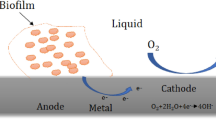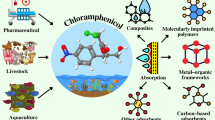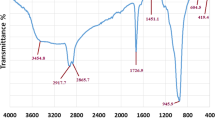Abstract
In order to control bacterial adhesion and metal corrosion in the circulating cooling water system, it is necessary to prepare a nanocomposite-modified coating with antibacterial and anticorrosive functions. Copper and zinc composite oxide (CuZnO) was synthesized to prepare CuZnO@RGO nanocomposites. The antibacterial mechanism of CuZnO@RGO nanocomposites was investigated using gram-negative bacteria E. coli and gram-positive bacteria S. aureus as the two model microorganisms. The antibacterial properties of CuZnO@RGO nanocomposites on mixed bacteria were researched in the cooling water system. In addition, the CuZnO@RGO waterborne polyurethane (WPU) composite coating (CuZnO@RGO/WPU) was synthesized. The antibacterial performance, hardness, and corrosion inhibition performance of CuZnO@RGO/WPU composite coating in the cooling water system were also investigated. The results showed that after adding CuZnO@RGO nanocomposites to E. coli or S. aureus suspension, the protein leakage after 20 h was 9.3 times or 7.2 times higher than that in the blank experiment. The antibacterial rate of CuZnO@RGO nanocomposites in circulating cooling water reached 99.70% when the mass fraction of RGO was 15%. When the mass fraction of CuZnO@RGO accounting for CuZnO@RGO/WPU composite coating was 2%, the antibacterial rate, hardness, and corrosion inhibition efficiency were 94.35%, 5H, and 93.30%, respectively.








Similar content being viewed by others
References
Akhavan O, Ghaderi E (2010) Toxicity of graphene and graphene oxide nanowalls against bacteria. ACS Nano 4:5731–5736
Alentejano CR, Aoki IV (2004) Localized corrosion inhibition of 304 stainless steel in pure water by oxyanions tungstate and molybdate. Electrochim Acta 49:2779–2785
Baek YW, An YJ (2011) Microbial toxicity of metal oxide nanoparticles (CuO, NiO, ZnO, and Sb2O3) to Escherichia coli, Bacillus subtilis, and Streptococcus aureus. Sci Total Environ 409:1603–1608
Bakhsheshi RHR, Hamzah E, Kasiri AM, Saud SN, Yaghoubidoust F, Akbari E (2016) Structure, corrosion behavior, and antibacterial properties of nanosilica/graphene oxide coating on biodegradable magnesium alloy for biomedical applications. Vacuum 131:106–110
Banerjee M, Mallick S, Paul A, Chattopadhyay A, Ghosh SS (2010) Heightened reactive oxygen species generation in the antimicrobial activity of a three component iodinated chitosan−silver nanoparticle composite. Langmuir 26:5901–5908
Chellaa S, Kollub P, Komaralac EVPR, Doshic S, Saranyaa M, Felixa S, Ramachandrana R, Saravanand P, Konerue VL, Venugopala V, Jeongf SK, Gracea AN (2015) Solvothermal synthesis of MnFe2O4-graphene composite—investigation of its adsorption and antimicrobial properties. Appl Surf Sci 327:27–36
CLSI (2018) Performance standards for antimicrobial susceptibility testing. M 100, 28th edn. Clinical and Laboratory Standard Institute, Wayne
Das MR, Sarma RK, Saikia R, Kale VS, Shelke MV, Sengupta P (2011) Synthesis of silver nanoparticles in an aqueous suspension of graphene oxide sheets and its antimicrobial activity. Colloid Surf B 83:16–22
Das MR, Sarma RK, Sch B, Kumari R, Saikia R, Deshmukh AB, Shelke MV, Sengupta P, Szunerits S, Boukherroub R (2013) The synthesis of citrate-modified silver nanoparticles in an aqueous suspension of graphene oxide nanosheets and their antibacterial activity. Colloid Surf B 105:128–136
Deˇdková K, Janíková B, Mateˇjová K, Cabanová K, Vánˇa R, Kalup A, Hundáková M, Kukutschová J (2015) ZnO/graphite composites and its antibacterial activity at different conditions. J Photochem Photobiol B 151:256–263
Gungor ND, Cotuk A, llhan-Sungur E, Cansever N (2015) Effect of mixed-species biofilm on copper surfaces in cooling water system. J Mater Eng Perform 24:848–858
He M, Wu T, Pan S, Xu X (2014) Antimicrobial mechanism of flavonoids against Escherichia coli, ATCC 25922 by model membrane study. Appl Surf Sci 305:515–521
Hu W, Peng C, Luo W, Lv M, Li X, Li D, Huang Q, Fan C (2010) Graphene-based antibacterial paper. ACS Nano 4:4317–4323
Jung WK, Koo HC, Kim KW, Shin S, Kim SH, Park YH (2008) Antibacterial activity and mechanism of action of the silver ion in Staphylococcus aureus and Escherichia coli. Appl Environ Microbiol 74:2171–2178
Lian P, Zhu X, Liang S, Li Z, Yang W, Wang H (2010) Large reversible capacity of high quality graphene sheets as an anode material for lithium-ion batteries. Electrochim Acta 55:3909–3914
Liu S, Zeng TH, Hofmann M, Burcombe E, Wei J, Jiang R, Kong J, Chen Y (2011a) Antibacterial activity of graphite, graphite oxide, graphene oxide, and reduced graphene oxide: membrane and oxidative stress. ACS Nano 5:6971–6980
Liu F, Zhao CC, Xia L, Yang F, Chang X, Wang YQ (2011b) Biofouling characteristics and identification of preponderant bacteria at different nutrient levels in batch tests of a recirculating cooling water system. Environ Technol 32:901–910
Liu J, Li F, Liu C, Wang HY, Ren BR, Yang K, Zhang EL (2014) Effect of Cu content on the antibacterial activity of titanium-copper sintered alloys. Mater Sci Eng C 35:392–400
Lu C, Mai YW (2011) Preparation, characterization and antibacterial properties of silver-modified graphene oxide. J Mater Chem 21:3350–3352
Meesters KPH, Van GJW, Gerritse J (2003) Biofouling reduction in recirculating cooling systems through biofiltration of process water. Water Res 37:525–532
Novakowski KE, Loukov D, Chawla V, Bowdish DME (2017) Bacterial binding, phagocytosis, and killing: measurements using colony forming units. Methods Mol Biol 1519:297–309
Novoselov KS, Geim AK, Morozov SV, Jiang D, Zhang Y, Dubonos SV, Grigorieva IV, Firsov AA (2004) Electric field effect in atomically thin carbon films. Science 306:666–669
Padmavathy N, Vijayaraghavan R (2011) Interaction of ZnO nanoparticles with microbes—a physio and biochemical assay. J Biomed Nanotechnol 7:813–822
Pourhashem S, Vaezi MR, Rashidi A, Bagherzadeh MR (2016) Exploring corrosion protection properties of solvent based epoxy-graphene oxide nanocomposite coatings on mild steel. Corros Sci 115:78–92
Pourhashem S, Vaezi MR, Rashidi A (2017) Investigating the effect of SiO2-graphene oxide hybrid as inorganic nanofiller on corrosion protection properties of epoxy coatings. Surf Coat Technol 493:111–122
Ramezanzadeh B, Haeri Z, Ramezanzadeh M (2016) A facile route of making silica nanoparticles-covered graphene oxide nanohybrids (SiO2-GO); fabrication of SiO2-GO/epoxy composite coating with superior barrier and corrosion protection performance. Chem Eng J 303:511–528
Rybalka KV, Beketaeva LA, Davydov AD (2014) Estimation of corrosion current by the analysis of polarization curves: electrochemical kinetics mode. Russ J Electrochem 50:108–113
Sirelkhatim A, Mahmud S, Seeni A, Kaus NHM, Ann LC, Bakhori SKM, Hasan H, Mohamad D (2015) Review on zinc oxide nanoparticles: antibacterial activity and toxicity mechanism. Nanomicro Lett 7:219–242
Solmaz R (2014) Investigation of corrosion inhibition mechanism and stability of vitamin B1 on mild steel in 0.5 M HCl solution. Corros Sci 81:75–84
Some S, Ho SM, Dua P, Hwanq E, Shin YH, Yoo H, Kang JS, Lee DK, Lee H (2012) Functions of highly potent graphene derivative-poly-l-lysine composites to inhibit bacteria and support human cells. ACS Nano 6:7151–7161
Sondi I, Salopek-Sondi B, Salopek-Sondi B (2004) Silver nanoparticles as antimicrobial agent: a case study on E. coli as a model for gram-negative bacteria. J Colloid Interface Sci 275:177–182
Tang EJ, Dong SY (2009) Preparation of styrene polymer/ZnO nanocomposite latex via miniemulsion polymerization and its antibacterial property. Colloid Polym Sci 287:1025–1032
Touhami F, Aouniti A, Abed Y, Hammouti B, Kertit S, Ramdani A, Elkacemi K (2000) Corrosion inhibition of armco iron in 1 M HCl media by new bipyrazolic derivatives. Corros Sci 42:929–940
Tu Y, Lv M, Xiu P, Huynh T, Zhang M, Castelli M, Liu Z, Huang Q, Fan C, Fan H, Zhou R (2013) Destructive extraction of phospholipids from Escherichia coli membranes by graphene nanosheets. Nat Nanotechnol 8:594–601
Veselý D, Kalendova A, Kalenda P (2010) A study of diatomite and calcined kaoline properties in anticorrosion protective coatings. Prog Org Coat 68:173–179
Wahab R, Siddiqui MA, Saquib Q, Dwivedi S, Ahmad J, Musarrat J, AI-Khedhairy AA, Skin HS (2014) ZnO nanoparticles induced oxidative stress and apoptosis in HepG2 and MCF-7 cancer cells and their antibacterial activity. Colloid Surf B 117:267–276
Wang HB, Hu C, Hu XX, Yang M, Qu JH (2012) Effects of disinfectant and biofilm on the corrosion of cast iron pipes in a reclaimed water distribution system. Water Res 46:1070–1078
Yu L, Zhang Y, Zhang B, Liu J (2014) Enhanced antibacterial activity of silver nanoparticles/halloysite nanotubes/graphene nanocomposites with sandwich-like structure. Sci Rep 4:4551–4555
Yu HY, Chen GY, Wang YB, Yao JM (2015) A facile one-pot route for preparing cellulose nanocrystal/zinc oxide nanohybrids with high antibacterial and photocatalytic activity. Cellulose 22:261–273
Zhang C, Chen M, Xu X, Zhang L, Zhang L, Xia F, Li X, Liu Y, Hu W, Gao J (2014) Graphene oxide reduced and modified by environmentally friendly glycylglycine and its excellent catalytic performance. Nanotechnology 25:135707
Zhao J, Wang Z, Dai Y, Xing B (2013) Mitigation of CuO nanoparticle-induced bacterial membrane damage by dissolved organic matter. Water Res 47:4169–4178
Funding
This research was financially supported by the Natural Science Foundation of Shandong Province, China (ZR201702140013).
Author information
Authors and Affiliations
Corresponding authors
Ethics declarations
Conflict of interest
The authors declare that they have no conflict of interest.
Additional information
Responsible editor: Philippe Garrigues
Publisher’s note
Springer Nature remains neutral with regard to jurisdictional claims in published maps and institutional affiliations.
Electronic supplementary material
The Supporting information is available including determination of hardness of composite coating, effect of the dosage of CuZnO@RGO nanocomposites on antibacterial rate, water quality analysis results for circulating cooling water used in the experiment, synthesis of CuZnO@RGO nanocomposites, effect of RGO mass fraction on antibacterial rate of CuZnO@RGO nanocomposites, effect of the dosage of CuZnO@RGO nanocomposites on antibacterial rate and effect of CuZnO@RGO mass fraction on antibacterial rate of CuZnO@RGO/WPU composite coating.
ESM 1
(DOCX 451 kb)
Rights and permissions
About this article
Cite this article
Jiang, G., Li, X., Che, Y. et al. Antibacterial and anticorrosive properties of CuZnO@RGO waterborne polyurethane coating in circulating cooling water. Environ Sci Pollut Res 26, 9027–9040 (2019). https://doi.org/10.1007/s11356-019-04374-0
Received:
Accepted:
Published:
Issue Date:
DOI: https://doi.org/10.1007/s11356-019-04374-0




